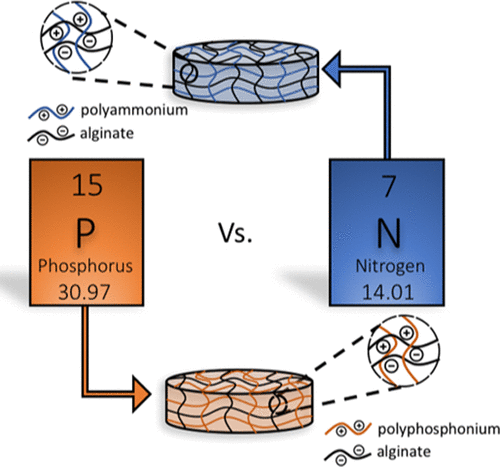Our official English website, www.x-mol.net, welcomes your feedback! (Note: you will need to create a separate account there.)
Phosphonium versus Ammonium Compact Polyelectrolyte Complex Networks with Alginate-Comparing Their Properties and Cargo Encapsulation.
Langmuir ( IF 3.9 ) Pub Date : 2020-06-22 , DOI: 10.1021/acs.langmuir.0c01370 Tristan D Harrison 1 , Alexandre J Salmon 1 , John R de Bruyn 2 , Paul J Ragogna 1 , Elizabeth R Gillies 1, 3
Langmuir ( IF 3.9 ) Pub Date : 2020-06-22 , DOI: 10.1021/acs.langmuir.0c01370 Tristan D Harrison 1 , Alexandre J Salmon 1 , John R de Bruyn 2 , Paul J Ragogna 1 , Elizabeth R Gillies 1, 3
Affiliation

|
Phosphonium and ammonium polymers can be combined with polyanions to form polyelectrolyte complex (PEC) networks, with potential application in self-healing materials and drug delivery vehicles. While various structures and compositions have been explored, to the best of our knowledge, analogous ammonium and phosphonium networks have not been directly compared to evaluate the effects of phosphorus versus nitrogen cations on the network properties. In this study, we prepared PECs from sodium alginate and poly[triethyl(4-vinylbenzyl)phosphonium chloride], poly[triethyl(4-vinylbenzyl)ammonium chloride], poly[tri(n-butyl)(4-vinylbenzyl)phosphonium chloride], poly[tri(n-butyl)(4-vinylbenzyl)ammonium chloride], and poly[tris(hydroxypropyl)(4-vinylbenzyl)phosphonium chloride]. These networks were ultracentrifuged to form compact PECs (CoPECs), and their physical properties, chemical composition, and self-healing abilities were studied. In phosphate-buffered saline, the phosphonium polymer networks swelled to a higher degree than their ammonium salt-containing counterparts. However, the viscous and elastic moduli, along with their relaxation times, were quite similar for analogous phosphoniums and ammoniums. The CoPEC networks were loaded with anions including fluorescein, etodolac, and methotrexate, resulting in loading capacities ranging from 5 to 14 w/w % and encapsulation efficiencies from 29 to 93%. Anion release occurred over a period of several days to weeks, with the rate depending largely on the anion structure and polycation substituent groups. Whether the cation was an ammonium or a phosphonium had a smaller effect on the release rates. The cytotoxicities of the networks and polycations were investigated and found to depend on both the network and polycation structure.
中文翻译:

带有海藻酸盐的磷对铵紧凑型聚电解质复合物网络-比较它们的性质和货物封装。
os和铵聚合物可以与聚阴离子结合形成聚电解质复合物(PEC)网络,并潜在地应用于自愈材料和药物输送工具中。尽管已经研究了各种结构和组成,但据我们所知,还没有直接比较类似的铵和phospho网络来评估磷对氮阳离子对网络性能的影响。在这项研究中,我们从海藻酸钠和聚[三乙基(4-乙烯基苄基)氯化phosph],聚[三乙基(4-乙烯基苄基)氯化铵],聚[三(正丁基)(4-乙烯基苄基)氯化phosph ]制备了PEC。],poly [tri(n-丁基)(4-乙烯基苄基)氯化铵]和聚[三(羟丙基)(4-乙烯基苄基)氯化phosph]。将这些网络进行超速离心以形成紧凑的PEC(CoPEC),并对其物理性质,化学成分和自我修复能力进行了研究。在磷酸盐缓冲盐水中,the聚合物网络比其含铵盐的对应物溶胀程度更高。然而,对于类似的and和铵,其粘弹性模量和弹性模量以及它们的弛豫时间非常相似。CoPEC网络中负载了包括荧光素,依托度酸和甲氨蝶呤在内的阴离子,负载量范围为5至14 w / w%,包封效率为29%至93%。阴离子释放发生了几天到几周的时间,速率主要取决于阴离子结构和聚阳离子取代基。阳离子是铵还是a对释放速率的影响较小。对网络和聚阳离子的细胞毒性进行了研究,发现它既取决于网络又取决于聚阳离子的结构。
更新日期:2020-07-21
中文翻译:

带有海藻酸盐的磷对铵紧凑型聚电解质复合物网络-比较它们的性质和货物封装。
os和铵聚合物可以与聚阴离子结合形成聚电解质复合物(PEC)网络,并潜在地应用于自愈材料和药物输送工具中。尽管已经研究了各种结构和组成,但据我们所知,还没有直接比较类似的铵和phospho网络来评估磷对氮阳离子对网络性能的影响。在这项研究中,我们从海藻酸钠和聚[三乙基(4-乙烯基苄基)氯化phosph],聚[三乙基(4-乙烯基苄基)氯化铵],聚[三(正丁基)(4-乙烯基苄基)氯化phosph ]制备了PEC。],poly [tri(n-丁基)(4-乙烯基苄基)氯化铵]和聚[三(羟丙基)(4-乙烯基苄基)氯化phosph]。将这些网络进行超速离心以形成紧凑的PEC(CoPEC),并对其物理性质,化学成分和自我修复能力进行了研究。在磷酸盐缓冲盐水中,the聚合物网络比其含铵盐的对应物溶胀程度更高。然而,对于类似的and和铵,其粘弹性模量和弹性模量以及它们的弛豫时间非常相似。CoPEC网络中负载了包括荧光素,依托度酸和甲氨蝶呤在内的阴离子,负载量范围为5至14 w / w%,包封效率为29%至93%。阴离子释放发生了几天到几周的时间,速率主要取决于阴离子结构和聚阳离子取代基。阳离子是铵还是a对释放速率的影响较小。对网络和聚阳离子的细胞毒性进行了研究,发现它既取决于网络又取决于聚阳离子的结构。


























 京公网安备 11010802027423号
京公网安备 11010802027423号